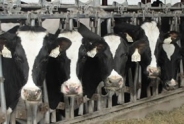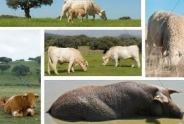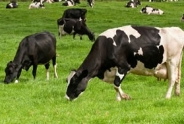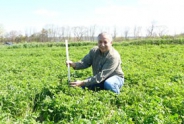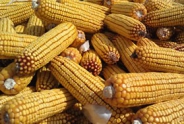First Cutting Updates - Week of May 22nd, 2017
Betsy Hicks, Area Dairy Specialist
South Central New York Dairy & Field Crops
UPDATES FOR THE WEEK OF MAY 22nd, 2017:
Mowing for all hay stands is well underway across the region. Some farms took advantage of the bit of nice weather and have finished up their first crop for their milking herd.
Points for the last week:
• Growth of alfalfa across the region reached anywhere from over 3" to almost 10" where there was ample sunlight and minimal rain/cloud activity.
• A weather event late last weekend that included hail damaged some alfalfa stands north and east of Cortland - fields were harvested soon after.
• In alfalfa, everything is either early bud or mid bud stage. The breaking point for mid-bud is about 30".
• There are some fields in the southern portion of our region that are dealing with alfalfa weevil and fields have been damaged.
• Heavy grass fields that have some alfalfa mixed with them seem to have alfalfa that is struggling. Orchard grass especially in mixed fields was towering over alfalfa.
Weather forecast looks like rain Thursday/Friday and Sunday/Monday. Slight chances of rain for next week every day (20%) but I'm sure there will be hay weather to be had.
Thoughts on pure grass fields that are past peak quality: If you are able to segregate your first cutting, you may want to leave your fields that are past peak quality and save them for dry cow or heifer feed and focus on getting your mixed fields in at peak quality. Certainly, field conditions will play a role, but yield can be a factor to take into account as well.
Please let us know conditions you observe while harvesting, and any comments back about the alfalfa height project are appreciated! We also welcome any sample results you would like to share, so forward them on me, bjh246@cornell.edu. You can also post harvest pictures on our team's Facebook page - https://www.facebook.com/SCNYDairyandFieldCropsTeam/ and use the hashtag #harvest2017.
Thank you, and stay safe!
Betsy
Additional Information:
The numbers that are indicators for using alfalfa heights for NDF content are as follows:
• 100% grass stands should be cut when nearby alfalfa is 14 inches tall, to achieve 50% NDF
• 50/50 mixed alfalfa/grass stands should be cut when nearby alfalfa is 22 inches tall, to achieve 44% NDF
• 100% alfalfa stands should be cut when alfalfa is 28 inches tall, to achieve 40% NDF
Predicted days to cut are based on daily NDF increases for grasses of 1.0% point, 50/50 mixed alfalfa/grass stands of 0.8% points, and alfalfa of 0.5% points and are adjusted for the coming week's weather. Typically NDF increases about 0.8 to 1.2 per day for grasses, with cooler weather being the lower end of the range and warmer weather being the higher end. For alfalfa, NDF increases about 0.4 to 0.7 per day, also dependent upon warm/cool weather.
The weekly email for the month of May will have a table of the locations around the region where we have measured the alfalfa height, as well as the elevation. Even if your fields aren't measured, you can use the location and elevation as a guide to conditions that may be similar to your own. We now cover six counties throughout South Central NY, including Tioga, Chemung, Broome, Tompkins, Cortland and Onondaga. Other teams and associations throughout the state are also measuring fields. For more information, contact that county's association to find out if fields are being measured there.
Alfalfa Heights - Week of May 22nd, 2017 (pdf; 223KB)
Upcoming Events
Labor Road Show IX
December 1, 2025
The Roadshow delivers essential updates on labor law, regulations, and workforce best practices—tailored for farm owners, managers, and ag service providers. Sessions also focus on practical strategies to boost communication, strengthen retention, and build a positive workplace culture.
Winter Bale Grazing Pasture Walk
January 10, 2026
Truxton, NY
Join us for the second Bale Grazing Winter Pasture Walk!
Have you heard about or seen bale grazing and wondered if it would work for you?
Do you want to learn the nuances and logistical context for implementing this regenerative practice?
Are you interested in seeing the impacts of bale grazing on land and animals from a practicing farmer?
If you answered Yes to any question, The Northeast Region National Grazing Lands Coalition, the Cornell Cooperative Extension Hillside Farms are teaming up to showcase our Second Bale Grazing Winter Pasture Walk!
Announcements
USDA Contract Freezes and Terminations: Legal Action Steps for Farmers
For Farmers with Signed EQIP and CSP ContractsThis resource is written for farmers and ranchers nationwide who have a signed contract with USDA NRCS under the EQIP or CSP program for environmental improvements but have concerns that their contract is frozen, under review, or terminated, and who are uncertain of their rights to receive reimbursement as well as their ongoing obligations under the signed contract.
Version: 1.0
Issue date: Feb 28, 2025
A downloadable factsheet is available at our BUSINESS tab on the top of our webpage.
Additional Information: www.farmcommons.org
USDA Contract Freezes: Filing an NAD Appeal or Demand Letter
This resource is written for farmers and ranchers nationwide who have a signed contract with USDA NRCS under the EQIP or CSP program for environmental improvements and want more information on the mechanics of filing a National Appeals Division (NAD) appeal. This resource includes sample letters.
USDA NAD Appeal https://www.usda.gov/about-usda/general-information/staff-offices/office-hearings-and-appeals/national-appeals-division/nad-appeals
Farm Participants Needed for Bale Grazing Grant!
Information on the Project:- Approximately 10 acres total needed to bale graze two different bale densities
- "Core" farms will graze two winters, "Demo" farms will graze one winter.
- Payments for both "Core" farms and "Demo" farms
- Baseline soil sampling by bale grazing team
- Forage measurements in early season by bale grazing team
- Late season clipping if residual not trampled down by farm
Cornell Cow Convos - New Podcast
On-going podcast, New episodes released on the last Thursday of the month.Guest speakers, CCE Dairy Specialists.
Housed on Soundcloud Channel is CCE Dairy Educators
- Preventative healthcare for cows
- The trend of beef on dairy
- What to look forward to in the new year for dairy
- Socially grouping or pair-housing calves
2018 Drug Residue Prevention Manual
For more than 30 years, the U.S. dairy industry has focused educational efforts on the judicious use of antibiotics through the annual publication of a Best Practices Manual. The 2018 edition of the National Dairy FARM Program: Farmers Assuring Responsible Management? Milk and Dairy Beef Drug Residue Prevention Manual is the primary educational tool for dairy farm managers throughout the country on the judicious and responsible use of antibiotics, including avoidance of drug residues in milk and meat.The manual is a quick resource to review those antibiotics approved for dairy animals and can also be used as an educational tool and resource for farm managers as they develop on-farm best management practices necessary to avoid milk and meat residues. Visit the Manual and Form Library to download copies of this important tool!
Follow us on Facebook
The team updates our facebook page frequently - follow us to be updated on our events, see some fun videos and get local area updates!facebook.com/SCNYDairyandFieldCropsTeam
NYSERDA Agriculture Energy Audit Program
NYSERDA offers energy audits to help eligible farms and on-farm producers identify ways to save energy and money on utility bills. Reports include recommendations for energy efficiency measures.For more information and the NYSERDA Agriculture Energy Audit Program Application click here

